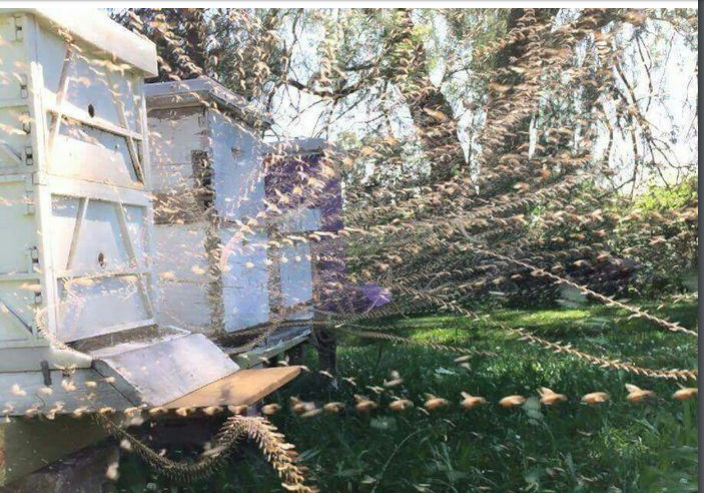Understanding the Beehive From a Military Tactical Perspective

By Dr Kevin Kraushaar PhD - Psychologist, EMDR Trauma Specialist, & Hobbyist Beekeeper.
Dr. Kevin Kraushaar is a trauma specialist who works with veterans with service histories ranging from the Second World War to modern day conflicts. He is passionate about mental health, and using his education and years of experience to improve the quality of life for those affected by their traumatic experiences.
Common Tactical Structures in Military & Animal Systems
Beginning with an intriguing title - I wish to propose that a military brigade command structure is NOT just an invention unique to humans. Beehives utilising brigade command structures (right down to unit levels) have been around since 3000BC, well before modern armies developed. Thus, I propose that colony command structures have existed in animal species, such as bees and ants - years before it was adopted by modern armies. Understanding the parallels to brigade and unit structures between military and animal systems can shed light on naturally existing tactical structures - such as the beehive. Humans understand the Armed Defence Forces (ADF) military command system well. Much like the ADF system, beehives share common command and warfare systems - similar structures that enhance survival.
“The BeeHive” is a thriving organism housing anywhere between 20,000 to 60,000 bee recruits (in peak foraging season) - functioning the same as a military tactical system. Bees being their time in the hive as raw recruits - engaging in 6-10 weeks of active duty. The first 3 weeks of life involves basic hive duties (cleaning, feeding larvae), whilst in the third week - the bee spends time doing hive entrance guard duties. The final weeks are spent completing field duties - the fourth week signals the beginning of several missions for the worker bee and training orientation flights. Once they have mastered these skills, they are subsequently assigned to units - acting and being trained as foraging recruits, completing exhaustive training in units, and foraging for nectar missions. These final weeks and nectar missions are completed to the point of exhaustion, flying up to 13 kilometre round trips. The endless, exhaustive nature of these field missions leave their bodies becoming physically broken - wings frayed with holes, inability to fly straight, with many failing to return (as long as daylight lasts).
Orderliness Minimises Mid-Air Crashes on Final Approach Runways
Foraging flight missions are analogous to RAAF operational missions - including inward & outward going flight paths (seen below in Figure 1 - a slow-motion time-lapse), purposeful air traffic control of bee recruits, structured inward and outward flight corridors and the strict maintenance of designated flight paths during missions. A lingering question is whether or not bees utilise roles similar to air-traffic controller systems that we don’t yet understand. Many beekeepers observe that through exhaustive flight training, bees ensure there are no mid-air collisions in the immediate airspace of the hive, at the entrance and the final approach runway, or the landing bay. The extensive training and degree of preparedness allows the unit to maintain organisation in missions beyond the hive, avoiding the tragedy of mid-air crashes.
Field Marshall (and later, Emperor) Napoleon Bonaparte appreciated the military significance of bees, including them in his royal crest. This inclusion gives reference to Bonaparte’s value of diligence, industriousness, and orderliness demonstrated by bees. Napoleon's concept of orderliness referred to the carrying out of an order unreservedly - even if a bee is wounded, or near death, all to protect the queen and other units of the hive. Natural bee enemies include ants, mice, frogs, toads, spiders, wasps, skunks (USA), and airborne birds, as in-flight predators. Unit preparedness, in combination with this drive to carry out an order, allows bees to complete their mission - all whilst avoiding the ongoing threat of these predators.
Figure 1 shows clear inward and outward flight corridors, which support close to thousands of foraging flights for nectar collection per day.Nectar supports and maintains the hive - feeding the other units of the brigade. Scouts and foraging nectar-gathering bees can travel up to 13.2 kilometres (8.25 miles) round trip from the hive - completing their due diligence in order to provide for the rest of their unit.

Hive Structures of Brigade & Division
Brigade headquarters is under a multi-faceted authority command - including the Queen, general unit commanders (or non-commissioned officers), and recruit trainers (older more experienced bees). They teach using the ‘learn by doing’ approach - acting to instruct new bee recruits, and give orders through their actions, pheromones, scents and antenna. This method resembles basic training tasks (e.g. grenade throwing) in a military mission and tactical system. Beehives have approximately 10-12 divisions, similar to a military Brigade structure - with the chief of staff or four-star general being a female, the Queen. The remaining bees engage in countless tactical functions - the heating and air-con crew, the nursery/rearing units, the Queen’s imperial guard and attendants units, hive cleaning units, water collection units, honey makers, landing strip and entrance bay guards units, honey and pollen ‘Q-store’ units, and navigators for food supplies (the list goes on). The largest units are foragers and flight units, with brigade special forces and kamikaze squads rounding off this military tactical brigade system. The only males within the brigade structure serve a specific ‘drone’ function - acting as sperm donors for the Queen to build the colony (sorry, guys!). The current theory is that the “Virgin Queen” mates with 50-70 drones on her maiden flight, stores millions of donated sperm - which is subsequently used throughout her lifespan. The full Queen will either return to swarm, or establish a new hive - beginning her queenship role by starting a new established, tactical hierarchy (Queen of the Brigade).
Engaging Special Forces Units
Recently, there has been an explosion of marketing and advertising about flow hives. Us hobbyist/amateur and professional beekeepers basically smile at pictures of a young child(ren), usually between the ages of 6-8, innocently approaching the flow-hive and turning on the tap to watch the honey flow. In our comparison to a military tactical system, approaching a tactical defended military position would not seem wise - without considering the risks involved. Approaching a hive that prioritises defence would put an individual at risk of being attacked by sentinels, or even the Queen. Even an ADF infantry unit wouldn’t approach an apiary of 30 hives without the appropriate veiled protection suit. The pictures don't tell the true story - why am I all kitted out in a full bee suit with gloves, veiled, smoker raging, when children can apparently approach in civilian clothing, and gleefully just turn the tap without the special forces signalling an attack?

Based on the hive as a military perspective, these ladies would be attacked by command of the queen in true military form - recruits would never let anyone get this close to the brigade headquarters.Threats would normally be attacked under the Commander in Chief’s hormone signals ordering dozens of special forces units to attack the intruders.
Spooks, Special Forces & Covert Operations
Some time in her chief-of-staff role during covert or special operations, it may become apparent that the Queen is not performing. Production numbers of bee recruits are down, various units are struggling, disease, or black beetle enemies are also now nesting in the hive. In response, a special forces and covert operations unit meets, and new orders are given - beginning the mission to eventually replace the Queen. Subsequent action can involve a number of eggs being covertly transferred from the bottom box (through the Queen separator), past the Imperial Guard to the second box by workers and special forces units, who have been co-opted as part of this new covert mission . If Queen cells are raised in the nursery (the bottom box), and this transfer is sighted by the Imperial Guard, the old Queen, or the newly emerged Virgin Queen - any one of them will kill the emerging-growing cells.
Experience seems possible, the queen has no say in the matter and the transfer of eggs to the second box is carried out by (covert) workers.
An interesting story of such a covert Queen operation is told in excellent style by Laline Paul (The Bees). In most events, once the Virgin Queen has emerged - she goes on her maiden flight to mate with drones. Once she returns, she either swarms, leaving with up to half brigade forces and existing units. Alternatively, both Queens may fight to the death. Usually, the younger Queen wins, or the new brigade commander and her swarm leaves the old hive - forcing the old hive to evolve. The new Chief-of- Staff swarms with most of her military units intact, and begins establishing a new brigade and military structure - laying and rearing new recruits, and directing the mission to rebuild units recruit numbers to full Brigade level again.
Encouraging Veterans to Understand the Military Tactical Perspective of Beehives
A final pathway to understanding the beehive from a military perspective is promoting the newly-introduced program where veterans living with PTSD and other physical and mental health conditions are trained in a program; Veterans as Beekeepers. During the last five years of this program, we have observed how bees come to understand, assess, and even know veterans. This program has established that beekeeping eventually helps veterans manage their PTSD, stress, depression, and anxiety levels - as well as their ongoing physical injury conditions. Functioning as beekeepers, veterans learn to physically confront special forces bees, their own adrenaline, PTSD triggers, and their nervousness and anxieties. Most notably, through beekeeping, veterans learn to confront their sense of fear of being wounded (being stung) - and if they remain careless, they’ll be stung not once, but many times. Veterans learn to walk a fine line of managing their fears to master working the hive, as well as maintaining their own sense of calmness, and self-awareness of past traumas.
Veterans as Beekeepers - a new, enhanced Mindfulness
I've discussed these moments with Veterans as Beekeepers - there is nothing more satisfying than sitting in a collapsible chair, ten metres away from their hives. Having the opportunity to drink a refreshing soda, eating some gummy bears or snakes, and observing their handiwork - considering the different stages of military activity and unit welfare in each of their hives. Sitting and watching the air-con units that work to maintain the temperature integrity of the brigade structure allows for a unique period of mindfulness - an opportunity to reflect. These quiet moments that involve assessing each future hives brigade to unit level of military preparedness, are a type of beekeeper’s mindfulness that hobbyists (and I) believe are parallel to the mindfulness moments veterans need. By meeting and engaging with a military tactical structure, veterans as beekeepers benefit themselves and society (with a sweet jar of honey they’ve helped produce). It is my belief and observation, through studying bee structural units and in conversation - there's no better satisfying yet mindful moment than encouraging veterans as beekeepers, as they play a part in a new military tactical mission that benefits society and their own personal growth.
References
1. A. I . Root (1954) ABC and XYZ of Bee Culture - 30th edition. First edition 1877. published by A. I. Root Company, Medina Ohio, USA. P5 “The duties of the young bee before flight.”
2. https://www.ngv.vic.gov.au/napoleon-and-the-bee/
3. https://www.honeyflow.com.au/collections/all
4. W. A. Goodacre 1964 Bees and Honey, (p39) NSW Department of Agriculture Government Printer Sydney.
5. Ditto 4 P39
6. Laline Paull (2014) “The Bees”. Sydney : Fourth Estate Publishing..
About Us
Anvil Training and Development is a group of Australian veterans who care about the physical and mental health of veterans and emergency service workers. We’re passionate about ongoing education and working with others to implement positive change.
Instagram: Anvil Training & Development - @anvil.td
Facebook: Anvil Training & Development - @anvil.td
www.anviltd.com
(Article Edited, Proof Read, and Fact-Checked by Charlotte Officer)
VES Mental Health Resources: https://anviltd.com/pages/ves-australian-mental-health-resources









Leave a comment